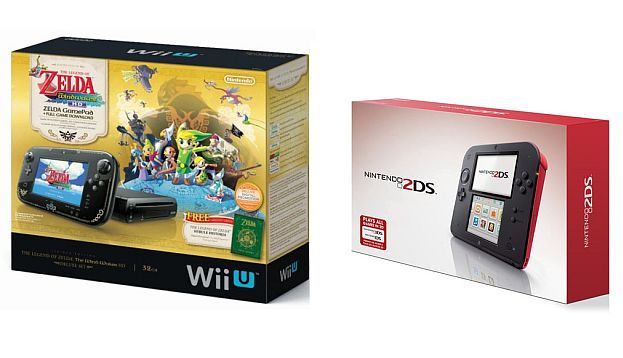Nintendo made news last week with two announcements, one widely anticipated and the other a complete surprise. With these announcements Nintendo has laid out its plan for the 2013 holiday season and given us a sense for its long-term strategy.
The announcement that the Wii U Deluxe Edition will be priced at $299 (a $50 drop) has been expected since before Sony announced the PlayStation 4 at $399. Slow Wii U sales this year have had analysts suggesting a price drop, with Nintendo CEO Iwata firmly resisting the idea at every opportunity. Since E3, Wii U sales have not revived even though Nintendo has announced several more compelling games coming soon.
The price drop is not as sweeping as it could have been. Effectively, Nintendo is dropping the 8GB Basic Edition of the Wii U, which never sold very well at $299. For an extra $50 you could get a copy of NintendoLand (a $50 retail price) as well as a 32GB version of the Wii U, so it’s little wonder the Wii U Deluxe Edition grabbed most of the sales. (The extra memory was especially useful since the operating system takes up about 4 GB of space.) From all reports, Nintendo will not be making any money on a 32GB Wii U sold for $299, so the company will be depending on software to bring in profits on that line.
The lineup of Wii U software going forward looks better than it has, with Nintendo preparing surefire sellers like Mario Kart 8 And Donkey Kong Country: Tropical Freeze. Still, the third-party lineup is thin, and all indicators are that publishers like EA and Activision won’t be putting much effort into new Wii U titles. If you’re a sports game fan, or a shooter fan, or an RPG fan, the Wii U likely won’t offer you many choices in the foreseeable future.
Realistically, the Wii U is not going to sell huge numbers when all of the attention and enthusiasm of gamers is focused on the Xbox One and the PlayStation 4 this fall. The pricing of the Wii U at $299 is smart, because dropping it to $249 probably wouldn’t boost sales much. There’s not all that much great software to be had for the Wii U still, so Nintendo has less ability to make up for losses on hardware with software profits. Thus, the $50 drop gives the Wii U some necessary psychological distance from the PlayStation 4 at $399, yet keeps Nintendo’s losses on hardware at a minimum.
Nintendo’s ability to succeed with the Wii U is not dependent on achieving status as the number one selling console. What’s important for Nintendo is truning a steady profit from the Wii U and its software lineup, and that’s certainly doable. The Wii U, with some marketing help and perhaps another price drop, should be able to hit GameCube like numbers of 30 million consoles sold. While far below the Wii’s performance, this is still a very solid goal that can generate some healthy profits for Nintendo down the road.
Meanwhile, Nintendo’s surprise announcement was the 2DS, a $129.95 slab-like device that plays DS and 3DS software (albeit without a 3D display). Essentially, the 2DS reduces costs on the 3DS by removing the 3D screen (which people rarely use, from all reports) and simplifying the case by removing the hinge. In a world where smartphones are ever more common among kids, providing a lower-cost way to access Nintendo’s increasingly powerful library of 3DS titles is a solid move that should be quite successful.
The difficult part of the 2DS/3DS line is the nomenclature and the possible confusion it may create in consumers, but some marketing and effective communication to retailers should make this a small issue. “Can it play the new Pokemon game †“Yes, no problem!†That’s really all you need to close the sale, especially when the $129 price tag is displayed. When this device can hit $99 (probably in a year), sales should really take off.
Price is the key marketing strategy here. Sure, the 2DS may not be as convenient for carrying around as the folding 3DS. You can’t slip it into a pocket, for one thing. But that pants pocket is probably already allocated to a smartphone, so this may not matter. What’s really important is that it gives gamers a lower cost way to get into Pokémon or Animal Crossing. Those young adults with fond memories of Nintendo now have an easier way to get their fix.
Third-party support for the 3DS has been strong, and continues to look good for the future. Of course, creating software for the 3DS is a lot less expensive than creating a Wii U title, so this should not be surprising. The continuing stream of interesting games for the 3DS is its vital lifeblood as it becomes the leading console for Nintendo.
Of course tablets and smartphones will continue to command attention from gamers, putting additional pressure on Nintendo to sell handheld consoles. The $169 3DS and the $199 3DS XL will have a tougher time in the year ahead, as tablets and smartphones continue to get more powerful and less expensive. For $199 you can get a 3DS XL, but for that same $199 you can get a tablet with a 7†HD quality screen and the ability to play hundreds of thousands of games as well as surf the Web, play movies and music, and an astonishing range of other capabilities. That’s a tough fight to win. Heading to the $129 price point (and someday to $99) is Nintendo’s best weapon in this fight.

